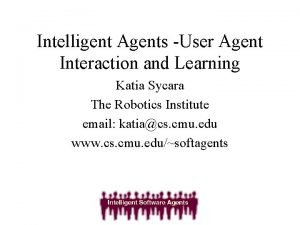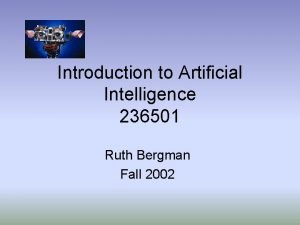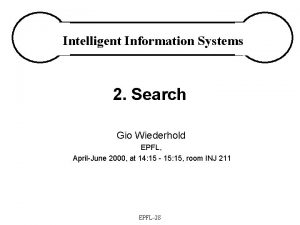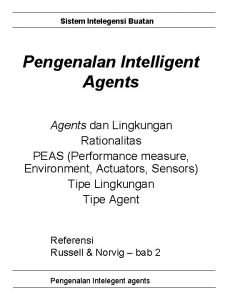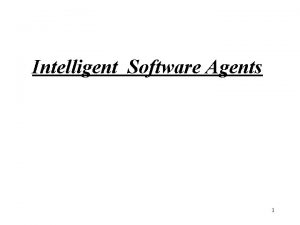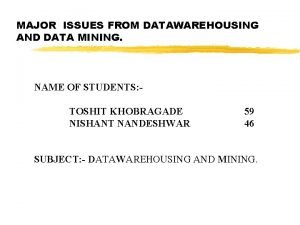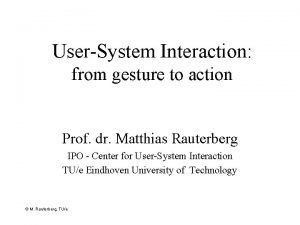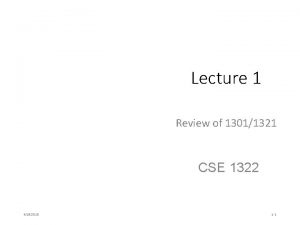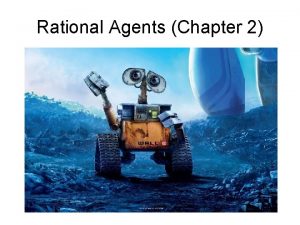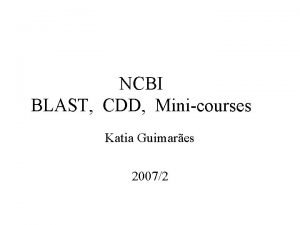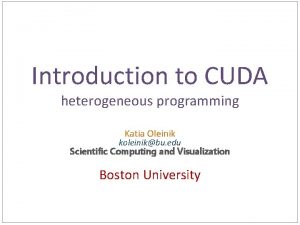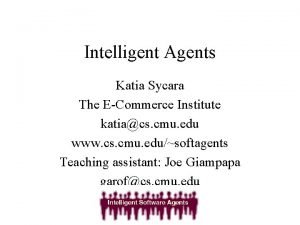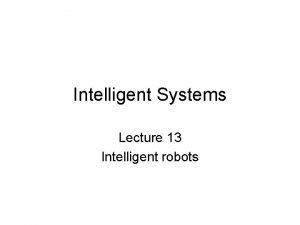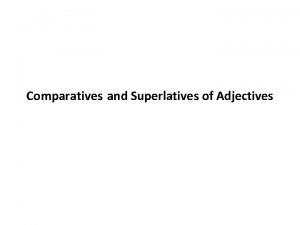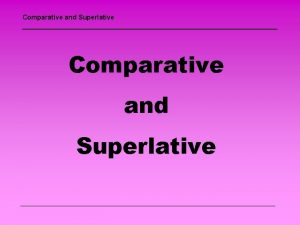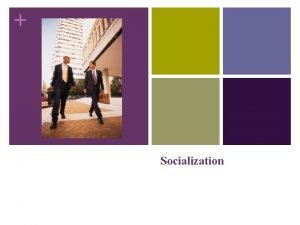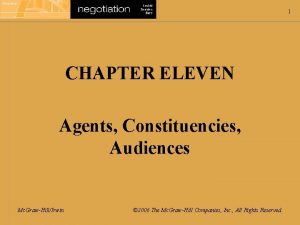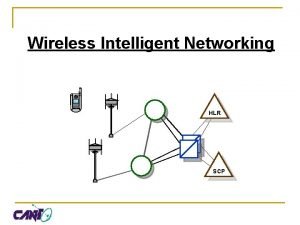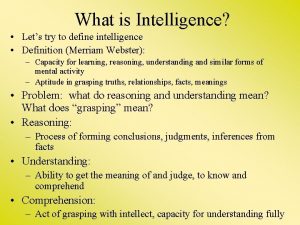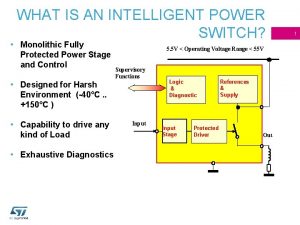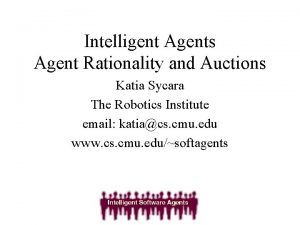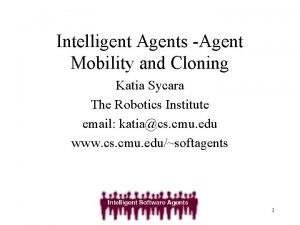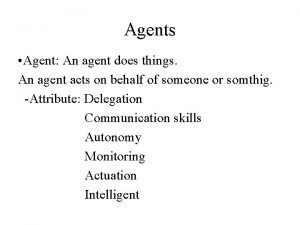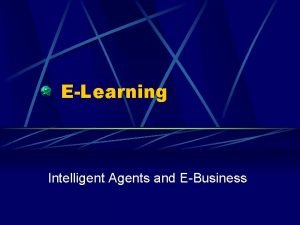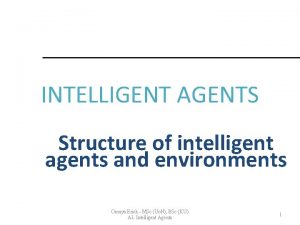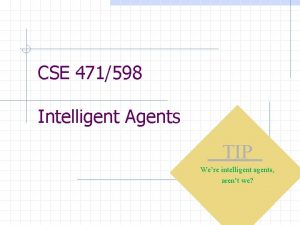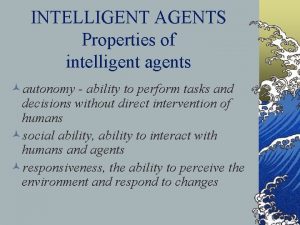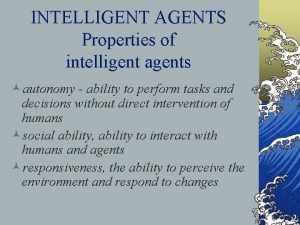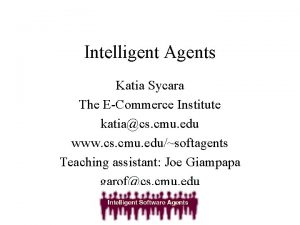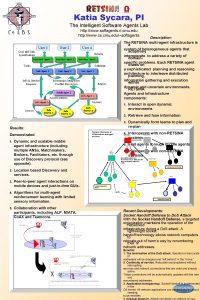Intelligent Agents User Agent Interaction and Learning Katia






















































- Slides: 54

Intelligent Agents -User Agent Interaction and Learning Katia Sycara The Robotics Institute email: katia@cs. cmu. edu www. cs. cmu. edu/~softagents

Why do we need to worry about security? • We want to deploy our system in open networks; – Agents come and go => agents interact with strangers; – Can agents be trusted? Can their deployers be trusted? • Agents are expected to do more serious things. Ex: – Getting info on your banking account; – Carry out sales transactions.

Security issues for mobile agents • Origin authentication; – Include public key certificate of the originator as part of the agent – In practice this is not enough; the entire agent must be signed and integrity-protected • Data Integrity – The body of the agent should be integrity protected, thus allowing for after-the-fact tampering detection

Security issues for mobile agents (cont) • Access/itinerary control – Restrict number and identity of the servers to be visited; however access control by naming severely restricts agent’s freedom – In practice, it may be better to manage agent access control via attributes, e. g. cpu available, agent origins, willingness to pay • Agent’s privacy – It is difficult to keep an agent protected from tampering – Tradeoff between the security advantages of fixed itineraries and the flexibility of free roaming

Security issues for mobile agents (cont) • Privacy and integrity of gathered information – In stateless information gathering, the agent intermittently sends acquired information back to its user. Protecting information is done by encrypting it. – In stateful information gathering, the gathered information is kept by the agent as it visits servers and is delivered upon the agent’s eventual return. A malicious execution environment could terminate the agent, thus preventing it from migrating further or returning.

Trusting your agents • Agents are delegated authority by their users • Agents behavior may not be predictable – While this is true of many application programs, they usually have very well-defined domains of action and so can be thoroughly tested. • Agents have a potential for causing damage

Trusting your agents (cont) • Testing and training the agent in safe mode (proposing but not allowed to execute actions) • Limited delegation • Verification through an audit trail • Reputation – Receiving a request from a “trusted” agent client, makes the request more trustworthy – If an agent reports information from a reputable source, it is more trustworthy – Reputation servers can keep track of agent behaviors

Testing and validation of agents • • • Testing and training the agent in safe mode --Testing is costly --Incremental testing --Agent should be configurable with realistic knowledge of its bounds --Ability to log every action, and basis of decisions it makes Validation – Harder for agents, e. g. if agents are learning, they could have nondeterministic behavior – Should be done in isolated environment – In conventional systems, one knows a priori the boundaries of the parameter space; this is not so with agents – Establish separate environment with historical data and replay the environment aganst the agents while monitoring the outcomes

Training your agent • By analogy to human training – Identify the goal – Identify the process – Explain the environment – Identify the limits of the trainee’s authority – Verify the results

Assumptions we make • Neither agents nor their deployers are trustworthy (They can misbehave): – Agents may eavesdrop on communication between two other agents; – An agent may masquerade as some other agent; – Agents may not behave as expected (e. g. , an agent may not want to pay for goods received). • There must be a few, selected entities that can be trusted.

Adding Security to Retsina (MAS in general) • Prevent misbehaviors from happening + have recovery mechanisms if they happen: – Identify different security issues that MAS face; – Propose solutions for these problems; – Design and implement a security infra-structure for Retsina. • Focus: application-independent issues: – Communication security: yes; – Fair exchange in electronic sales: no. • Approach: Standard security techniques used in distributed systems – Authentication; – Access control; – etc.

Security Threats in MAS • System-level threats: Those that subvert inter-agent interactions, independently of the application a system is running. – Untrustworthy ANSs and matchmakers; – Untrustworthy application agents; – Insecure communication channels. • Application-level threats: Those that subvert the security of applications. They may exist even if the underlying system of agents is secure. – Service providers that do not implement appropriate access control policies; – Untrustworthy application agents.

Our Solution (1) • To guarantee the integrity of naming and matchmaking services: – Include access control: – <use> trusted ANSs and matchmakers! • Make agents uniquely identifiable, and give them unforgeable proofs of identity: – Prevents spoofing; • Make deployers of agents liable for the actions of their agents: – Agents are given proofs of identity only when deployers allow their own identities to be linked with those of their agents.

Our Solution (2) • Protect communication channels; • Add access control mechanisms (which usually rely on the delegators’ Ids); • Make agents prove that they are delegates of whom they claim to be.

A Design of a Security Infra-structure for Retsina Assumptions: • Deployers have public key certificates binding their physical identities (SSN, company names, etc. ) to their public keys; • DCAs are assumed to exist (lie outside our security infra-structure); • ANSs and matchmakers – are trusted entities; – their public keys are publicly known. • The addresses of ANSs are publicly known.

Public Key Cryptography • Key pairs: – Private keys: a ; – Public keys: A ; pub(a) • Digital signatures: (m)a • Signature verification: – Use A to verify (m)a • Public key certificates: – (Name, Public key)ca

Giving Identities to Agents + Establishing Liability (1) 1. Choose an Agent ID AID 2. Generate a public key pair {a, pub(a)} 3. m 1=(certify AID, pub(a), t)d 4. Verify the validity of the request 5. Generate m 2=ACA-signed certificate binding pub(a) to AID 6. Creates an entry [D’s public key certificate, m 1] in the certification DB 8. Verify the signature in m 2 with ACA’s public key.

Giving Identities to Agents + Establishing Liability (2) • Agents are given: – a public key certificate, and – a matching private key. • The certification process: – certification can be requested only by deployers who can prove their own identities => make the deployer aware of his or her liabilities.

Revoking an Agent’s Public Key

Registering at an ANS

Unregistering at an ANS

The Lookup Protocol Agents are identified by their keys, and not their names!!

Matchmaker Protocols • Very similar to ANS protocols; • Differences: – Physical addr may not be shared by more than one agent; capabilities may; – Agents use ANSname. Agentname to register with the matchmaker; – The lookup protocol: 1. CAP 2. [CAP, {[ANS-x 1. AID 1, CERT 1], … [ANS-xn. AIDn, CERTn]}, T]mm

Secure Communication Channels • SSL (Netscape’s Secure Socket Layer protocol); • Why? – Keep communication security transparent from the application; – Off-the-shelf trustworthy technology (extensible too). • Implementation: – Local effort: at the Communicator.

Secure Delegation + Access Control • Knowing who is the delegator may be necessary or desirable; • Original design: Have the agent know the secret key of its deployers; • Weaknesses: – Agents should not know such important secrets; – Sometimes they do not even have to know (ex: PIN); – Should have a “weaker, ” “temporary” solution.

Some Interesting Pages • http: //microsoft. com/security/tech/certificates/formats. asp – Some introductory material on standards for cryptographic object; • http: //security. dstc. edu. au/projects/java/release 3. html – Info on a real-world security package (can download the code and play); • Communications of the ACM - June 1996, volume 39, Number 6 – An issue dedicated to EC; from which the article is extracted.

Adaptability • Adaptability of an individual agent – Agent Communication – Agent Coordination – Agent Planning – Agent Scheduling – Agent Execution Monitoring • Learning from interactions (user or other agents) • Organizational adaptability (middle agents) • Performance adaptability (cloning) ___________ Sycara, “Levels of Adaptivity in Systems of Coordinating Information Agents”, Lecture Notes in Artificial Intelligence 1435, Klusch and Weiss (Eds. ), July 1998 CIA’ 98

User Agent Interaction and Learning • Agent can be pre-programmed – efficient but could be inflexible • User explicitly delegates goal to an agent through end user programming – flexible but difficult • Agent learns from user interactions – metaphor of agent as apprentice.

User Agent Interaction and Learning (cont) • Instruction – a set of directions to the agent on how to carry out a task • Confirmation – a request for user’s approval before the agent carries out an instruction • Observation – a behavioral pattern learned by the agent • Suggestion – an agent recommendation to the user

User Agent Interaction and Learning (cont) • Instruction – user can either instruct the agent directly or accept the agent’s offer of automation for an observed work pattern • When the agent informs of an observation, the user can: – accept the observation and have the agent create an instruction – decline the observation – edit the observation to fine-tune the instruction – postpone a decision till later

Learning Approaches • Machine learning plus Rule based, or expert system – machine learning for knowledge acquisition and rule based inference for knowledge maintenance • Case-based reasoning – based on past experiences/cases that contain – the problem – attributes of the situation/context – the solution – indication of success or failure of the solution

Learning Approaches (cont) • Neural Networks – self-organizing learning approach • Various statistical clustering techniques – perform classification of concepts

Fact Interpretation for Agent-User Interaction • User behavior Agent interpretation rule • user declines agent offer to automate-- offer less general observation • user repeatedly undoes agent action -- offer to turn off existing rule • user sometimes undoes agent action -- offer to make rule more specific to match condition • • agent interaction preference does not match user behavior -offer to change preference

Agent Apprentice Assistance • • In-context tips Coaching when the user needs help Proactive Assistance Shortcuts for a sequence of steps Customized offer based on learned user preferences Automation offer for repetitive user tasks Automation suggestions based on what the user is not doing • Notification of significant events

Control Delegation of Actions • Confirm Once-- the agent displays a confirmation message only before the first time it carries out the instruction • Confirm Always-- the agent displays a confirmation message every time before it carries out an instruction • Don’t Confirm -- the agent never confirms with the user before carrying out the instruction

Information Search • Ways to Find Information – Browsing: Following hyper-links that seem of interest – Searching: Sending a query to a search engine such as Lycos – Categories: Following existing categories such as Yahoo • Problems – Spent a lot of time and effort to navigate. Can search be made more efficient? – Search but it is difficult to accurately express the user’s intention. – Search engines are not personalized

Web Site Personalization • Personalized newspaper-- a publisher can deliver personalized news to each of its subscribers • Personalized store fronts: An on-line merchant can make customized recommendations based on user preferences and transaction history • Customized service providers: An on-line service provider can make personalized recommendations (video, ads etc) based on individual user preferences and preferences of other users

Personalization Content • User Data – – demographic information (e. g. , age, gender) dynamic user interests (e. g. music, travel) user transaction history (e. g. seasonal purchases) user behavior at a site (e. g. hyperlinks clicked) • User data in user data base for use during recommendations – indexing provided through data base tables – indexing through engine such as Verity Search for web pages

Personalized Web site Operation • Agent collects new content from web or other content data bases • Users register their interests with the agent using profiles • Agent serves new information to users according to their preferences • Using machine learning, agent learns more about users from what they click and where they go • Agent suggests changes to the user and learns from feedback • After each successive visit, the agent gives new information and ideas matching user interests and preferences

Level of Personalization • Customization--user fills out profile and agent delivers content according to it. But, this approach requires user to change preference profile • Learning user interests. --agent watches over user shoulder • Learning community behavior. -- agent compares user preferences to those of others with similar interests. This approach encourages user exploration

User Experience • Explicit vs implicit ranking--some collaborative filtering tools require that users explicitly rank an initial amount of pages. This imposes additional burden on the user • User identification-- user name and password; use of cookies during revisits.

Collaborative Filtering A collaborative filtering system makes recommendations based on the preferences of similar users. People: Yenta, Referral Web Products: Firefly, Tunes, Syskill & Webert Readings: Wisewire, Phoaks

Content vs. Collaboration • Content-based retrieval returns documents that are similar to a query (search) or a user profile (preference) • Collaborative recommendation retrieves documents liked by others with similar profiles

Problems in Collaborative Filtering Incentives & Startup • Need a critical mass of users/recommenders to make meaningful predictions • Need mechanisms to maintain participation Reliability • Spoofing- will content providers inflate their ratings • Technical problems with clustering & similarity measures Privacy • Once you share your profile who else may want it?

Functionality of Web. Mate • Learning user’s interests for information filtering – Multiple TF-IDF vectors representation – Incremental and adaptive Learning – Compile personal newspaper • Support for efficiently finding information – Automatic refinement using Trigger Pairs – Relevance feedback _______________ Chen, Sycara, “Web. Mate: A Personal Agent for Browsing and Searching”, Proceedings of the Second International Conference on Autonomous Agents, Minneapolis, MN, May 1998

Learning to extract information Maulsby, David & Ian Witten (1997). Teaching agents to learn: From user study to implementation. IEEE Computer, Nov, 36 -43. Problem: Features of materials prepared for human viewing such webpages or printed text are designed to make it easy for us to extract information but can be very difficult for a computer. Telling a computer “how” to extract information rather than just which URL to open can be a hard problem.

How We Extract Information Repetitive information such as bibliographic records, on-line classifieds, or catalogs usually use some combination of: • visual demarcations (such as ruled lines or tables) • visual distinctions (such as italics, color, or indentation) • punctuation (such as commas, colons, or periods) • precedence/succession relations among informational elements

But How do we tell a computer what these visual cues are? We don’t want to write a parser We don’t want to write & debug a production system We may not even know what the markup looks like So… How do we tell an agent how to do it (from our point of reference) so it can do it (from its point of reference). .

Mausby’s Study Problem: Train a program to recognize and translate between bibliographic entries in a variety of formats Approach: • Wizard of Oz study to find out how people would like to instruct a computer in doing the task • Implement/test a system that takes instruction of this sort

Instructing as Machine Learning • Learns incrementally and adds exceptions as they are encountered • Uses demonstration (point/select) and “verbal” instruction such as “precedes” • Proposes “guesses” when classification is ambiguous • Learns Perl style patterns for things such as phone numbers and uses punctuation and capitalization as referents in rules

CIMA/TURVEY Rules • Learns DNF rules. . Greedy with exceptions tacked on. . • As a result of pointing, clicking, indicating precedes/follows, etc. CIMA can generate rules which do things such as “recognize” phone numbers with or without area code, identify the surname and forename/initials of the first author of a paper and similar feats. .

Adaptive Negotiation (the Bazaar Model) • Aims at modeling multi-issue negotiation processesª • Combines the strategic modeling aspects of game-theoretic models and single agent sequential decision making models • Supports an open world model • Addresses heterogeneous multi-agent learning utilizing the iterative nature of sequential decision making and the explicit representation of beliefs about other agents _______________ ª D. Zeng and K. Sycara. “Bayesian Learning in Negotiation. ” International Journal of Human. Computer Studies (1998), 48, pp. 125 -141.

Utility of Learning: Experimental Design • The set of players N is comprised of one buyer and one supplier who make alternative proposals. • For simplicity, the range of possible prices is from 0 to 100 units and this is public information • The set of possible actions (proposed prices by either the buyer or the supplier) A equals to {0, 1, 2, …, 100} • Reservation prices are private information. • Each player's utility is linear to the final price ( a number between 0 and 100) accepted by both players • Normalized Nash product as joint utility (the optimal joint utility when full information is available is 0. 25)

Average Performance of Three Experimental Configurations in Bazaar • A non-learning agent makes decisions based solely on his own reservation price • A learning agents makes decisions based on both the agent's own and the opponent's reservation price
 Public agent katia
Public agent katia 236501
236501 Performance environment actuators sensors
Performance environment actuators sensors Structure of intelligent agents
Structure of intelligent agents Intelligent agents epfl
Intelligent agents epfl Contoh peas
Contoh peas Contoh peas kecerdasan buatan
Contoh peas kecerdasan buatan Software agent definition
Software agent definition Known malicious user-agents
Known malicious user-agents Mining methodology and user interaction issues
Mining methodology and user interaction issues Which is the oxidizing agent?
Which is the oxidizing agent? Oxidizing and reducing agents
Oxidizing and reducing agents Single user and multiple user operating system
Single user and multiple user operating system Types of operating systems
Types of operating systems Fluidity in hci
Fluidity in hci User system interaction
User system interaction User interaction
User interaction Redox reaction in alkaline medium
Redox reaction in alkaline medium Agent function vs agent program
Agent function vs agent program Agent function
Agent function User agent windows 7
User agent windows 7 Evosts
Evosts Smartuseragent
Smartuseragent Katia bunaux
Katia bunaux Katia stocco smole
Katia stocco smole Vodafone business cloud
Vodafone business cloud Rogaka
Rogaka Katia laudicella
Katia laudicella Katia
Katia Ncbi
Ncbi Coding with katia
Coding with katia Katia sycara
Katia sycara Katia jean baptiste
Katia jean baptiste Vergonha de mim
Vergonha de mim Katia schiavone
Katia schiavone Cuadro comparativo e-learning y b-learning
Cuadro comparativo e-learning y b-learning Reinforcement learning agent environment
Reinforcement learning agent environment Decision support systems and intelligent systems
Decision support systems and intelligent systems Superlative de easy
Superlative de easy Comparative and superlative de comfortable
Comparative and superlative de comfortable Conventional computing and intelligent computing
Conventional computing and intelligent computing Secondary socializing agents
Secondary socializing agents How to identify the oxidizing agent
How to identify the oxidizing agent Weathering
Weathering Differentiate between oxidizing and reducing agents
Differentiate between oxidizing and reducing agents Known vs unknown environment
Known vs unknown environment Relative strengths of oxidizing and reducing agents
Relative strengths of oxidizing and reducing agents How agents, constituents and audiences change negotiations?
How agents, constituents and audiences change negotiations? Inductive and analytical learning
Inductive and analytical learning Inductive analytical approach to learning
Inductive analytical approach to learning Eager vs lazy
Eager vs lazy Tony wagner's seven survival skills
Tony wagner's seven survival skills Scp wike
Scp wike Definitions of intelligence
Definitions of intelligence Vni4140
Vni4140
